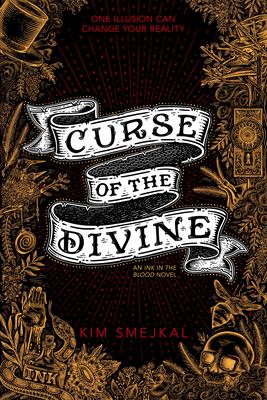
With more ink on my skin than my husband, I am a sucker for fantasy books that revolve around magic tattoos. Granted, they haven’t been the greatest stories I have ever read, but that doesn’t stop me from reading them. Kim Smejkal’s Ink in the Blood rewarded me for my interest, so I was really looking forward to the story’s finale, Curse of the Divine. Sadly, everything I loved about the first book failed to impress me this time around.
What impressed me so much about the first novel was Ms. Smejkal’s critique of organized religion, her use of auras – visible to everyone – to identify gender fluidity, and the idea of magic tattoos. In Curse of the Divine, we get away from two of the three elements, and the story suffers. For one, Celia destroyed the existing organized religion in the first book, so there can be no criticism of it. Instead, Celia must deal with the one person who may be able to save her friends from a terrible fate, one that has nothing to do with religion. For me, dealing with someone who has delusions of grandeur is not as enjoyable as criticizing organized religion in any form.
At the same time, Curse of the Divine moves away from magic tattoos and instead focuses on the actual ink Celia used in the magic tattoos. Rather than sending secret messages, she learns that one can use the ink to manipulate the corporeal world. While impressive and more than a little foreboding, it is a much more serious consequence of using the ink. No matter how dark the first novel got, there was still a feeling of whimsy at the idea that Celia could use her ink to send messages to friends whenever she wanted. Now that Celia uses the ink to change the world around her, that whimsy disappears, making the story something entirely different and not, in my opinion, in a good way.
Plus, the origins of the ink, something we find out in the novel, are disappointing. I don’t know exactly what I was expecting, but I was expecting something much more earth-shattering than the information we obtain. It is a bit as if Ms. Smejkal used all her allotted creativity for the first story and had to rely on old standby explanations for the sequel.
Thankfully, Ms. Smejkal does still include gender-identifying auras and their infinite nuances. In fact, Celia ruminates on the beauty of gender fluidity and the freedom to change whenever you desire. She describes the auras as something so beautiful, it makes me wish they were real. Not only would it end the confusion over designated gender versus biological sex, but it would also remind people that we are beautiful no matter how we express ourselves.
I find that Curse of the Divine is four hundred pages of Celia dealing with the trauma she faced at the end of the first book followed by fifty pages of acceptance, forgiveness, and understanding so that Celia can obtain closure. While that closure is satisfying in its way, the journey to get there is less creative than in the first novel. There is less bite, less social critique, and a whole lot more hand-wringing, something I never thought I would see in Celia’s character.
